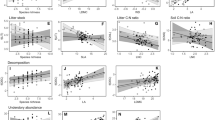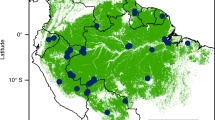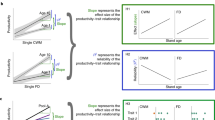Abstract
Biodiversity can be measured by taxonomic, phylogenetic, and functional diversity. How ecosystem functioning depends on these measures of diversity can vary from site to site and depends on successional stage. Here, we measured taxonomic, phylogenetic, and functional diversity, and examined their relationship with biomass in two successional stages of the broad-leaved Korean pine forest in northeastern China. Functional diversity was calculated from six plant traits, and aboveground biomass (AGB) and coarse woody productivity (CWP) were estimated using data from three forest censuses (10 years) in two large fully mapped forest plots (25 and 5 ha). 11 of the 12 regressions between biomass variables (AGB and CWP) and indices of diversity showed significant positive relationships, especially those with phylogenetic diversity. The mean tree diversity-biomass regressions increased from 0.11 in secondary forest to 0.31 in old-growth forest, implying a stronger biodiversity effect in more mature forest. Multi-model selection results showed that models including species richness, phylogenetic diversity, and single functional traits explained more variation in forest biomass than other candidate models. The models with a single functional trait, i.e., leaf area in secondary forest and wood density in mature forest, provided better explanations for forest biomass than models that combined all six functional traits. This finding may reflect different strategies in growth and resource acquisition in secondary and old-growth forests.


Similar content being viewed by others
References
Balvanera P, Pfisterer AB, Buchmann N et al (2006) Quantifying the evidence for biodiversity effects on ecosystem functioning and services. Ecol Lett 9:1146–1156. doi:10.1111/j.1461-0248.2006.00963.x
Baraloto C, Paine CET, Poorter L, Beauchene J, Bonal D, Domenach AM, Hérault B, Patiño S, Roggy JC, Chave J (2010) Decoupled leaf and stem economics in rain forest trees. Ecol Lett 13(11):1338–1347
Barrufol M, Schmid B, Bruelheide H et al (2013) Biodiversity promotes tree growth during succession in subtropical forest. PLoS One 8:e81246
Barton K (2014) Package ‘MuMIn’. R package version 1:0–7
Brose U, Hillebrand H (2016) Biodiversity and ecosystem functioning in dynamic landscapes. Philos Trans R Soc B 371:20150267. doi:10.1098/rstb.2015.0267
Burnham KP, Anderson DR (2002) Model selection and multimodel inference: a practical information-theoretic approach, 2nd edn. Springer-Verlag, New York
Cadotte MW (2015) Phylogenetic diversity and productivity: gauging interpretations from experiments that do not manipulate phylogenetic diversity. Funct Ecol 29(12):1603–1606
Cadotte MW, Cardinale BJ, Oakley TH (2008) Evolutionary history and the effect of biodiversity on plant productivity. Proc Natl Acad Sci USA 105:17012–17017. doi:10.1073/pnas.0805962105
Cadotte MW, Cavender-Bares J, Tilman D et al (2009) Using phylogenetic, functional and trait diversity to understand patterns of plant community productivity. PLoS One 4:e5695. doi:10.1371/journal.pone.0005695
Caldeira MC, Ryel RR, Lawton JH et al (2001) Mechanisms of positive biodiversity-production relationships: insights provided by 13C analysis in experimental Mediterranean grassland plots. Ecol Lett 4:439–443. doi:10.1046/j.1461-0248.2001.00238.x
Campanello PI, Gatti MG, Goldstein G (2008) Coordination between water-transport efficiency and photosynthetic capacity in canopy tree species at different growth irradiances. Tree Physiol 8:85–94. doi:10.1093/treephys/28.1.85
Cardinale BJ, Ives AR, Inchausti P (2004) Effects of species diversity on the primary productivity of ecosystems: extending our spatial and temporal scales of inference. Oikos 104:4376–4450. doi:10.1111/j.0030-1299.2004.13254.x
Cardinale BJ, Srivastava DS, Duff JE et al (2006) Effects of biodiversity on the functioning of trophic groups and ecosystems. Nature 443:9896–9992. doi:10.1038/nature05202
Cardinale BJ, Wright JP, Cadotte MW et al (2007) Impact of plant diversity on biomass production increase through time because of species complementarity. Proc Natl Acad Sci 104:18123–18128. doi:10.1073/pnas.0709069104
Cardinale BJ, Venail P, Gross K et al (2015) Further re-analyses looking for effects of phylogenetic diversity on community biomass and stability. Funct Ecol 29:1607–1610. doi:10.1111/1365-2435.12540
Cavanaugh KC, Gosnell JS, Davis SL et al (2014) Carbon storage in tropical forest correlates with taxonomic diversity and functional dominance on a global scale. Glob Ecol Biogerogr 23:563–573. doi:10.1111/geb.12143
Chave J, Coomes D, Jansen S et al (2009) Towards a worldwide wood economics spectrum. Ecol Lett 12:351–366. doi:10.1111/j.1461-0248.2009.01285.x
Chazdon RL (2008) Chance and determinism in tropical forest succession. In: Carson WP, Schnitzer SA (eds) Tropical forest community ecology. Wiley, Chichester, pp 384–408
Chisholm RA, Muller-landau HC, Rahman KA et al (2013) Scale-dependent relationships between tree species richness and ecosystem function in forests. J Ecol 101:1214. doi:10.1111/1365-2745.12132
Condit R (1998) Tropical forest census plots. Springer, Berlin
Cornwell WK, Schwilk DW, Ackerly DD (2006) A trait-based test for habitat filtering: convex hull volume. Ecology 87(6):1465–1471
Faith DP (1992) Conservation evaluation and phylogenetic diversity. Biol Conserv 61:1–10. doi:10.1016/0006-3207(92)91201-3
Flynn DFB, Mirotchnick N, Jain M et al (2011) Functional and phylogenetic diversity as predictors of biodiversity-ecosystem function relationships. Ecology 92:1573–1581. doi:10.1890/10-1245.1
Forrester DI, Bauhus J (2016) A review of processes behind diversity—productivity relationships in forests. Curr For Rep 2(1):45–61. doi:10.1007/s40725-016-0031-2
Goldberg DE (1990) Components of resource competition in plant communities. In: Grace JB, Tilman D (eds) Perspectives on plant competition. Academic Press, San Diego, pp 27–49
Hao ZQ, Zhang J, Song B et al (2007) Vertical structure and spatial associations of dominant tree species in an old growth temperate forest. For Ecol Manag 25:1–11. doi:10.1016/j.foreco.2007.06.026
Hao ZQ, Zhang J, Li BH et al (2008) Natural secondary poplar-birch forests in Changbai mountain: species composition and communities structure. J Plant Ecol 32:251–261 (in Chinese with English abstract)
Hooper DU, Chapin FS, Ewel JJ et al (2005) Effects of biodiversity on ecosystem functioning: a consensus of current knowledge. Ecol Monogr 75:3–35. doi:10.1890/04-0922
Jonsson M (2006) Species richness effects on ecosystem functioning increase with time in an ephemeral resource system. Acta Oecol 29:72–77. doi:10.1016/j.actao.2005.08.002
Kelly ME, Loughrey D, Lawlor BA, Robertson LH, Walsh C, Brennan S (2014) The impact of cognitive training and mental stimulation on cognitive and everyday functioning of healthy older adults: a systematic review and meta-analysis. Ageing Res Rev 15:28–43
Kembel SW, Cowan PD, Helmus MR et al (2010) Picante: R tools for integrating phylogenies and ecology. Bioinformatics 26:1463–1464. doi:10.1093/bioinformatics/btq166
Kunstler G, Falster D, Coomes DA, Hui F, Kooyman RM, Laughlin DC, Poorter L, Vanderwel M, Vieilledent G, Wright SJ, Aiba M, Baraloto C, Caspersen J, Cornelissen JH, Gourlet-Fleury S, Hanewinkel M, Herault B, Kattge J, Kurokawa H, Onoda Y, Peñuelas J, Poorter H, Uriarte M, Richardson S, Ruiz-Benito P, Sun IF, Ståhl G, Swenson NG, Thompson J, Westerlund B, Wirth C, Zavala MA, Zeng H, Zimmerman JK, Zimmermann JK, Westoby M (2016) Plant functional traits have globally consistent effects on competition. Nature 529(7585):204–207
Laliberté E, Legendre P (2010) A distance-based framework for measuring functional diversity from multiple traits. Ecology 91:299–305. doi:10.1890/08-2244.1
Lasky JR, Uriarte M, Boukili V et al (2014) The relationship between tree biodiversity and biomass dynamics changes with tropical forest succession. Ecol Lett 17:1158–1167. doi:10.1111/ele.12322
Letcher SG, Chazdon RL (2009) Rapid recovery of biomass, species richness, and species composition in a forest chronosequence in northeastern Costa Rica. Biotropica 41:608–617. doi:10.1111/j.1744-7429.2009.00517.x
Liu JJ, Zhang XX, Song FF et al (2015) Explaining maximum variation in productivity requires phylogenetic diversity and single functional traits. Ecology 96(1):176–183. doi:10.1890/14-1034.1
Loreau M (1998) Biodiversity and ecosystem functioning: a mechanistic model. Proc Natl Acad Sci USA 95:5632–5636
Loreau M, Hector A (2001) Partitioning selection and complementarity in biodiversity experiments. Nature 412(6842):72–76
Májeková M, de Bello F, Doležal J et al (2014) Plant functional traits asdeterminants of population stability. Ecology 95:2369–2374. doi:10.1073/pnas.95.10.5632
Meinzer FC, Woodruff DR, Domec J-C et al (2008) Coordination of leaf and stem water transport properties in tropical forest trees. Oecologia 156:31–41. doi:10.1007/s00442-008-0974-5
Moore AD (1989) On the maximum growth equation used in forest gap simulation models. Ecol Model 45:63–67. doi:10.1016/0304-3800(89)90100-2
Morin X, Fahse L, Scherer-Lorenzen M, Bugmann H (2011) Tree species richness promotes productivity in temperate forests through strong complementarity between species. Ecol Lett 14:1211–1219. doi:10.1111/j.1461-0248.2011.01691.x
Nguyen H, Herbohn J, Firn J et al (2012) Biodiversity–productivity relationships in small-scale mixed-species plantations using native species in Leyte province, Philippines. For Ecol Manag 274:81–90. doi:10.1016/j.foreco.2012.02.022
Paquette A, Messier C (2011) The effect of biodiversity on tree productivity: from temperate to boreal forest. Glob Ecol Biogeogr 20:170–180. doi:10.1111/j.1466-8238.2010.00592.x
Pavoine S, Bonsall MB (2011) Measuring biodiversity to explain community assembly: a unified approach. Biol Rev 86:792–812. doi:10.1111/j.1469-185X.2010.00171.x
Pérez-Harguindeguy N, Díaz S, Garnier E et al (2013) New handbook for standardised measurement of plant functional traits worldwide. Aust J Bot 61:167–234. doi:10.1071/BT12225
Petchey OL, Gaston KJ (2002) Functional diversity (FD), species richness and community composition. Ecol Lett 5:402–411. doi:10.1046/j.1461-0248.2002.00339.x
Reich PB (2014) The worldwide “fast–slow” plant economics spectrum: a traits manifesto. J Ecol 102:275–301. doi:10.1111/1365-2745.12211
Reich PB, Tilman D, Isbell F et al (2012) Impacts of biodiversity loss escalate through time as redundancy fades. Science 336:589–592. doi:10.1126/science.1217909
Roscher C, Schmid B, Buchmann N et al (2011) Legume species differ in the responses of their functional traits to plant diversity. Oecologia 165:437–452. doi:10.1007/s00442-010-1735-9
Roscher C, Schumacher J, Gubsch M et al (2012) Using plant functional traits to explain diversity-productivity relationships. PLoS One 7:e36760. doi:10.1371/journal.pone.0036760
Ruiz-Benito P, Gómez-Aparicio L, Paquette A et al (2014) Diversity increases carbon storage and tree productivity in Spanish forests. Glob Ecol Biogeogr 23:311–322. doi:10.1111/geb.12126
Ruiz-Jaen MC, Potvin C (2011) Can we predict carbon stocks in tropical ecosystems from tree diversity? Comparing species and functional diversity in a plantation and a natural forest. New Phytol 189:978–987. doi:10.1111/j.1469-8137.2010.03501.x
Slik JWF, Bernard CS, Breman FC, van Beek M, Salim A, Sheil D (2008) Wood density as a conservation tool: quantification of disturbance and identification of conservation-priority areas in tropical forests. Conserv Biol 22(5):1299–1308
Spasojevic MJ, Suding KN (2012) Inferring community assembly mechanisms from functional diversity patterns: the importance of multiple assembly processes. J Ecol 100:652–661. doi:10.1111/j.1365-2745.2011.01945.x
Tilman D, Knops J, Wedin D, Reich P, Ritchie M, Siemann E (1997) The influence of functional diversity and composition on ecosystem processes. Science 277:1300–1302. doi:10.1126/science.277.5330.1300
Venail P, Gross K, Oakley TH et al (2015) Species richness, but not phylogenetic diversity, influences community biomass production and temporal stability in a re-examination of 16 grassland biodiversity studies. Funct Ecol 29(5):615–626. doi:10.1111/1365-2435.12432
Vilà M, Vayreda J, Gracia C et al (2003) Does tree diversity increase wood production in pine forests? Oecologia 135:299–303. doi:10.1007/s00442-003-1182-y
Vilà M, Vayreda J, Comas L et al (2007) Species richness and wood production: a positive association in Mediterranean forests. Ecol Lett 10:241–250. doi:10.1111/j.1461-0248.2007.01016.x
Violle C, Navas ML, Vile D et al (2007) Let the concept of trait be functional! Oikos 116:882–892. doi:10.1111/j.2007.0030-1299.15559.x
Wang XG, Wiegand T, Hao Z et al (2010) species association in an old-growth temperate forest in north-eastern China. J Eco 98:674–686. doi:10.1111/j.1365-2745.2010.01644.x
Wang XG, Swenson NG, Wiegand T et al (2013) Phylogenetic and functional diversity area relationships in two temperate forests. Ecography 36:1–11. doi:10.1111/j.1600-0587.2012.00011.x
Webb CO, Donoghue MJ (2005) Phylomatic: tree assembly for applied phylogenetics. Mol Ecol Notes 5:181–183. doi:10.1111/j.1471-8286.2004.00829.x
Weis JJ, Cardinale BJ, Forshay KJ et al (2007) Effect of species diversity on community biomass production change over the course of succession. Ecology 88:929–939. doi:10.1890/06-0943
Wright IJ, Reich PB, Westoby M et al (2004) The worldwide leaf economics spectrum. Nature 428:821–827. doi:10.1890/09-2335.1
Wu X, Wang XP, Tang ZY et al (2014) The relationship between species richness and biomass change form boreal to subtropical forest in China. Ecography 37:1–12. doi:10.1111/ecog.00940
Xu HC (2001) Natural forests of Pinus Koraiens is in China. China Forestry Publishing House, Beijing (in Chinese)
Yang H, Li D (1985) Distribution patterns of dominant tree species on northern slope of Changbai Mountain. Res For Ecosyst 5:1–14 (in Chinese)
Yuan ZQ, Gazol A, Wang X et al (2011) Scale specific determinants of tree diversity in an old growth temperate forest in China. Basic Appl Ecol 12:488–495. doi:10.1016/j.baae.2011.07.008
Yuan ZQ, Gazol A, Wang XG et al (2012) What happens below the canopy? Direct and indirect influences of the dominant species on forest vertical layers. Oikos 121:1145–1153. doi:10.1111/j.1600-0706.2011.19757.x
Yuan ZQ, Gazol A, Wang XG et al (2016) Pattern and dynamics of biomass stock in old growth forests: the role of habitat and tree size. Acta Oecol 75:15–23. doi:10.1016/j.actao.2016.06.007
Zanne AE, Tank DC, Cornwell WK et al (2014) Three keys to the radiation of angiosperms into freezing environments. Nature 506:89–92. doi:10.1111/j.1600-0706.2011.19757.x
Zhang Y, Chen HYH, Reich PB (2012) Forest productivity increases with evenness, species richness and trait variation: a global meta-analysis. J Ecol 100:742–749. doi:10.1111/1365-2745.12425
Zhao FQ, He HS, Dai L et al (2014) Effects of humans disturbances on Korean pine coverage andage structure at a landscape scale n northeast China. Ecol Eng 71:375–379. doi:10.1016/j.ecoleng.2014.07.072
Zuppinger-Dingley D, Schmid B, Petermann JS et al (2014) Selection for niche differentiation in plant communities in increased biodiversity effects. Nature 515:108–111. doi:10.1038/nature12872
Zuur AF, Ieno EN, Valker NJ et al (2009) Mixed effects models and extensions in ecology with R. Springer, New York
Acknowledgments
We are grateful to the editor and two anonymous reviewers for helpful comments on a previous version of the manuscript. This study was financially supported by the external cooperation program of BIC, Chinese Academy of Sciences (151221KYSB20130003), National Natural Science Foundation of China (41301057 and 31370444). JM and ML were supported by the TULIP Laboratory of Excellence (ANR-10-LABX-41). AG was supported by a Postdoctoral grant from MINECO (Contrato Formación Postdoctoral MINECO––FPDI 2013-16600, FEDER funds). SW gratefully acknowledges the support of the German Centre for Integrative Biodiversity Research (iDiv) Halle-Jena-Leipzig funded by the German Research Foundation (FZT 118). This paper was also supported by CFERN & GENE award funds on ecological paper. The authors declare that they have no conflict of interest.
Author contribution statement
ZQ and WX conceived and designed the experiments, ZQ, YJ, LF and WX performed the experiments, ZQ, SW and AG analyzed the data, ZQ, SW, AG and ML wrote the manuscript, other authors provided editorial advice.
Author information
Authors and Affiliations
Corresponding author
Additional information
Communicated by Katherine L. Gross.
Electronic supplementary material
Below is the link to the electronic supplementary material.
Rights and permissions
About this article
Cite this article
Yuan, Z., Wang, S., Gazol, A. et al. Multiple metrics of diversity have different effects on temperate forest functioning over succession. Oecologia 182, 1175–1185 (2016). https://doi.org/10.1007/s00442-016-3737-8
Received:
Accepted:
Published:
Issue Date:
DOI: https://doi.org/10.1007/s00442-016-3737-8




